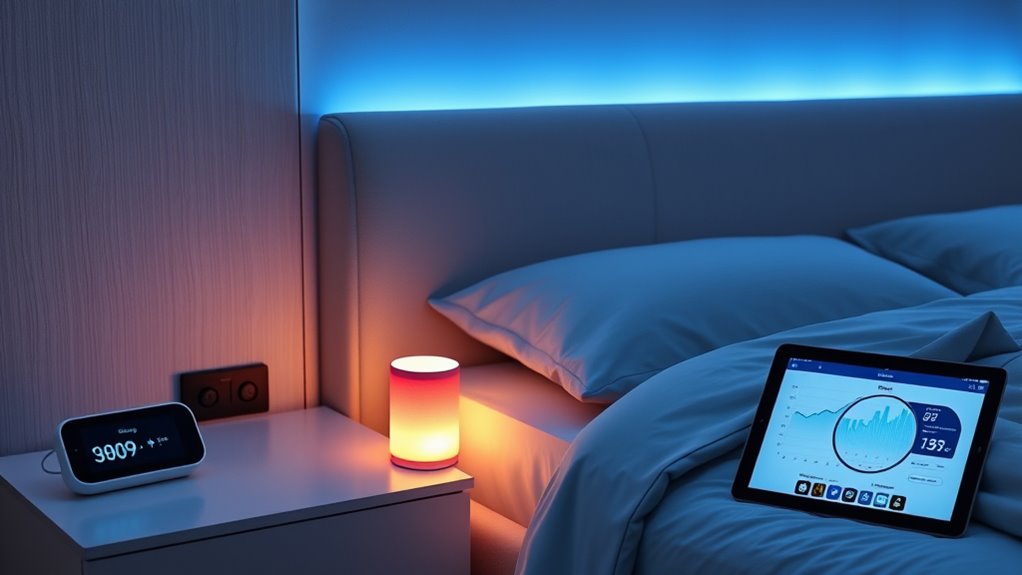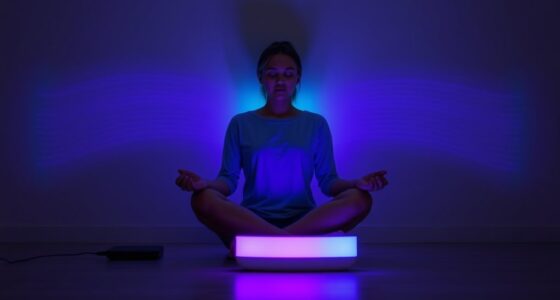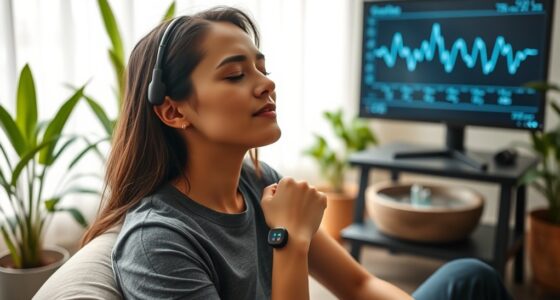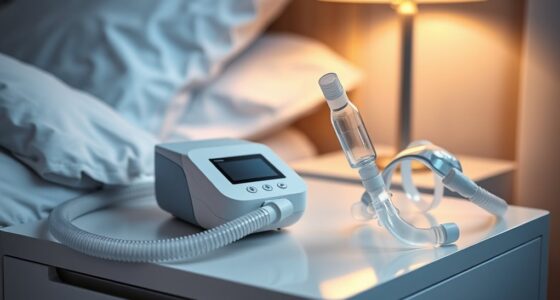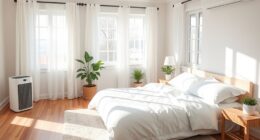Integrating smart home technology with your sleep gadgets makes nighttime routines easier and more personalized. You can control devices like smart mattresses, lighting, and thermostats with voice commands or automated schedules, ensuring a seamless experience. These systems provide data on your sleep quality and can adjust settings in real-time for better rest. By setting up centralized control and routines, you’ll enjoy a more restful night. Keep exploring to reveal even more ways to optimize your sleep environment.
Key Takeaways
- Centralized control systems unify various sleep devices for easy management through apps or voice commands.
- Automated routines trigger lighting, temperature, and sound adjustments to optimize sleep environments consistently.
- Voice control enables effortless, hands-free adjustments and complex commands for nightly sleep setups.
- Sleep data integration provides insights for personalized environment tweaks to improve sleep quality over time.
- Smart home integration streamlines bedtime routines, enhances convenience, and promotes better sleep through tailored automation.
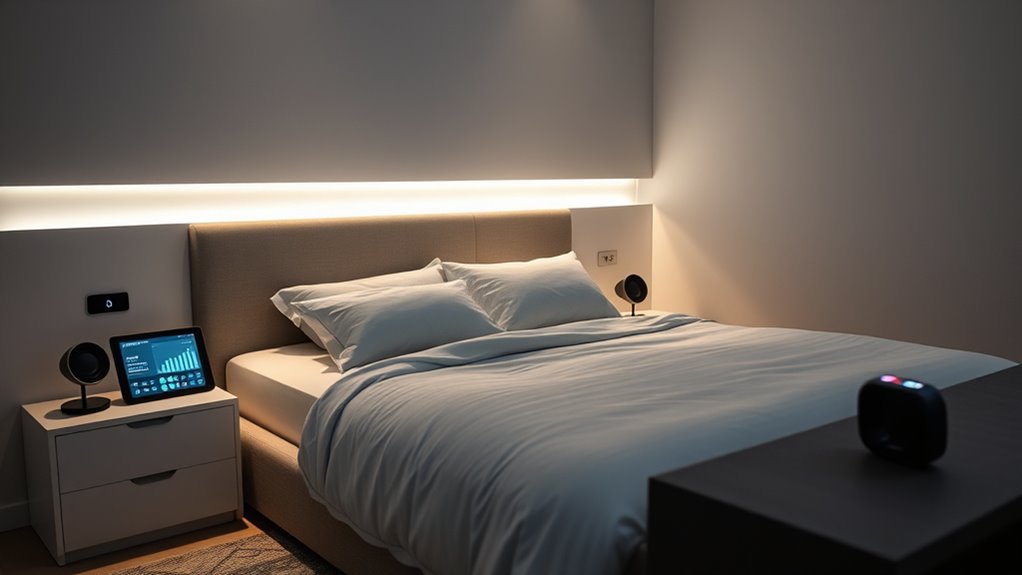
Smart home integration has revolutionized the way you manage your sleep environment, making it easier to create a personalized and restful nightly routine. With voice control, you can effortlessly adjust your smart gadgets without leaving your bed or reaching for your phone. Imagine saying, “Good night,” and having your smart lights dim, your blackout curtains close, and your sleep sounds start playing—all in one seamless command. This convenience not only streamlines your evening but also reduces the hassle of managing multiple devices separately.
Automated routines take this convenience even further. You can set a series of actions that trigger at specific times or under certain conditions, ensuring your environment is always optimized for sleep. For example, you might program a routine that gradually dims your lights, adjusts your smart thermostat to a comfortable temperature, and activates your sleep tracker as you wind down. Once the routine is scheduled, it runs automatically every night, so you don’t need to remember to make those adjustments manually. This consistency helps train your body to recognize bedtime cues, improving your overall sleep quality.
Integrating sleep gadgets through a smart home hub or app means you can control everything from a single interface. Whether it’s your smart mattress, white noise machine, or ambient lighting, you get centralized control and can customize settings for different nights or preferences. Many systems allow you to create personalized scenes that activate with a single tap or voice command, making it easy to switch between routines for weekdays and weekends. Using voice commands also means you can make quick adjustments without disrupting your sleep, like increasing the sleep sound volume or turning on a nightlight.
Furthermore, smart home integration enhances your ability to monitor sleep patterns and make data-driven improvements. Many sleep gadgets sync with your home automation system, providing insights into your sleep quality, duration, and disturbances. You can use this information to refine your routines, such as adjusting lighting levels or temperature settings to find what helps you sleep best. Over time, the combination of voice control, automated routines, and data analysis creates a more responsive sleep environment that adapts to your needs and lifestyle. Additionally, smart home integration can help identify sleep disruptions and suggest adjustments to improve overall rest.
Frequently Asked Questions
Can Sleep Gadgets Automatically Adjust Based on My Sleep Patterns?
Yes, sleep gadgets can automatically adjust based on your sleep patterns. They use adaptive algorithms and sleep cycle analysis to monitor your sleep in real-time. When they detect changes or disruptions, they adapt settings like lighting, temperature, or sound to optimize your sleep environment. This personalized approach helps improve your sleep quality by responding dynamically to your needs, ensuring you wake up feeling more refreshed and rested.
Are There Privacy Concerns With Smart Home Sleep Device Integrations?
You might worry about privacy concerns with smart home sleep device integrations, and it’s valid. While these gadgets collect sensitive data, manufacturers often use data encryption and user authentication to protect your information. However, vulnerabilities can still exist if security measures aren’t robust. Staying informed about device updates and choosing reputable brands helps guarantee your sleep data remains private and secure, giving you peace of mind.
How Secure Are Data Transmissions Between Sleep Gadgets and Smart Home Systems?
You might wonder how secure data transmissions are between your sleep gadgets and smart home systems. Generally, strong encryption protocols protect your data, making it difficult for hackers to access sensitive information. However, no system is completely immune to data breaches. Staying updated on security features and choosing reputable devices helps guarantee your sleep data remains private and secure during transmission.
Can Multiple Users Personalize Their Sleep Settings Within One Smart Home Setup?
They say, “Many hands make light work,” and with smart home setups, multiple users can personalize their sleep settings through user profiles and device customization. You simply create individual profiles, adjusting preferences like lighting, temperature, and sleep routines. The system recognizes each user, ensuring everyone’s preferences are met without interference. This way, your smart home adapts seamlessly, making restful nights personalized and effortless for everyone in the household.
What Is the Compatibility Range of Various Sleep Gadgets With Different Smart Home Platforms?
You want to know about device compatibility and platform integration for sleep gadgets. Most modern sleep devices are designed to work with popular smart home platforms like Alexa, Google Home, and Apple HomeKit. However, compatibility varies by device. Check each gadget’s specifications to verify it seamlessly integrates with your preferred platform. This way, you can control your sleep environment effortlessly and customize settings across different devices within your smart home ecosystem.
Conclusion
As you weave your sleep gadgets into your smart home, you’re not just syncing devices—you’re planting seeds for restful nights and brighter mornings. Each connection symbolizes a bridge between technology and tranquility, turning your space into a sanctuary. Embrace this integration as nurturing a garden of peace within your home, where every device is a blooming flower, guiding you toward serenity and rejuvenation. Your smart home becomes a reflection of your commitment to restful, meaningful sleep.
